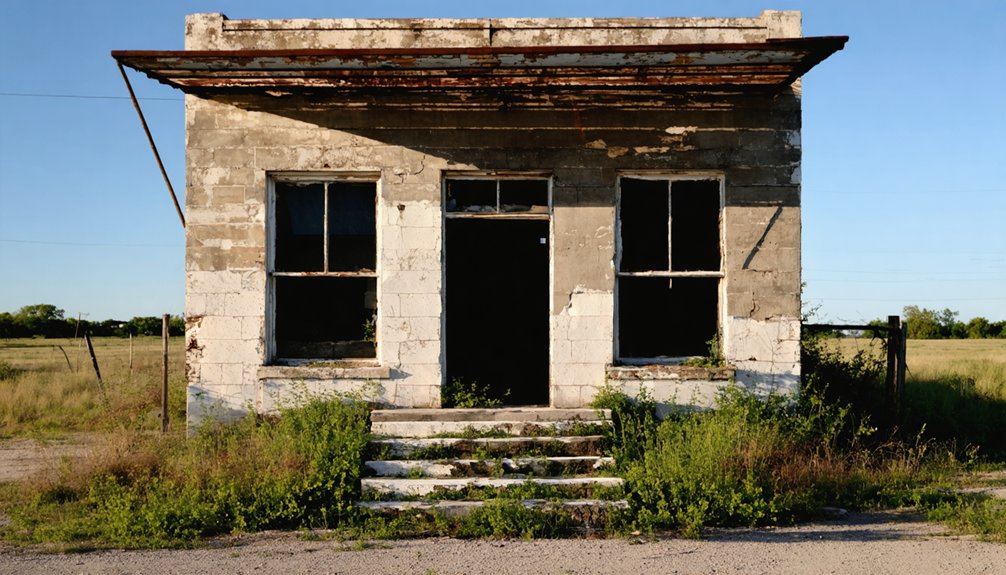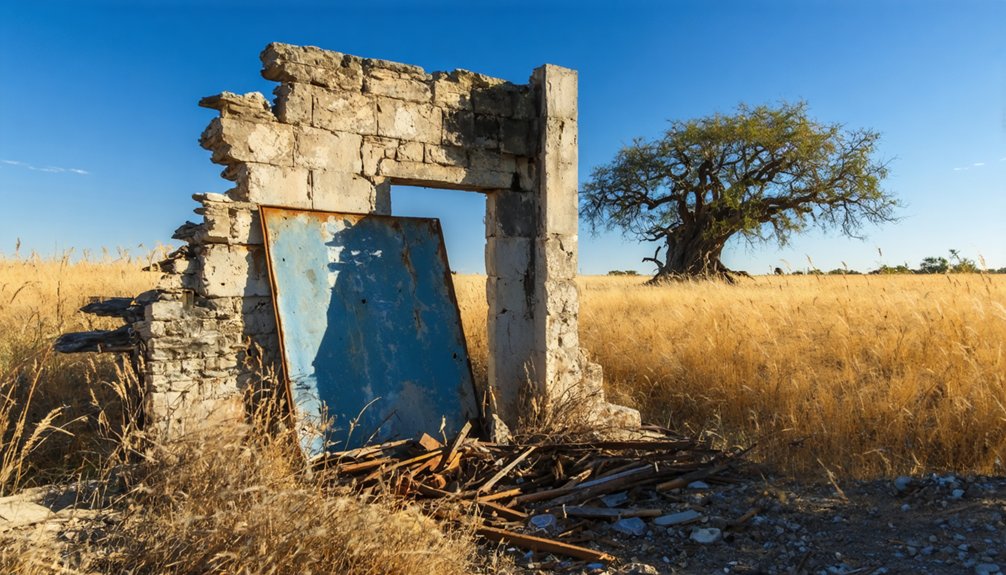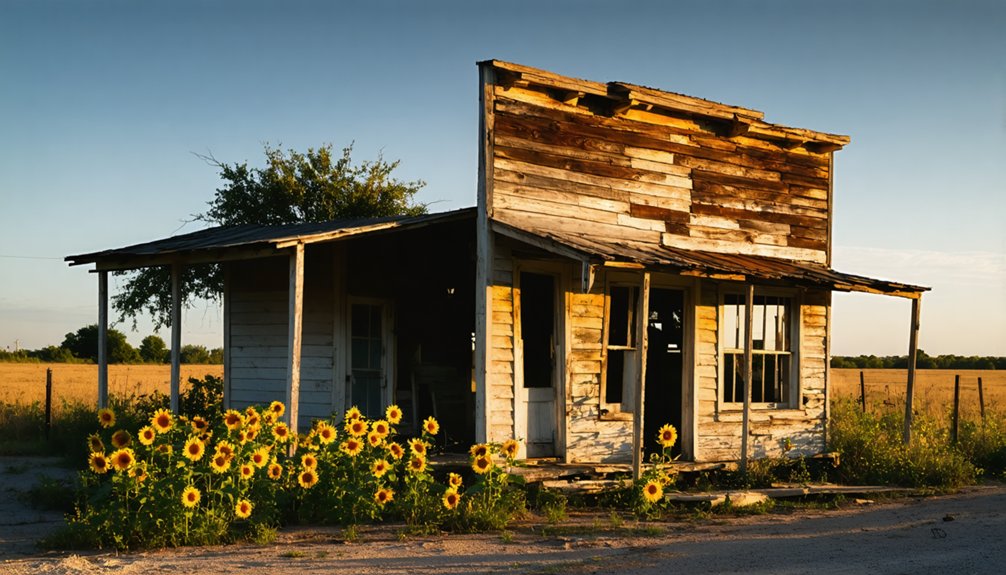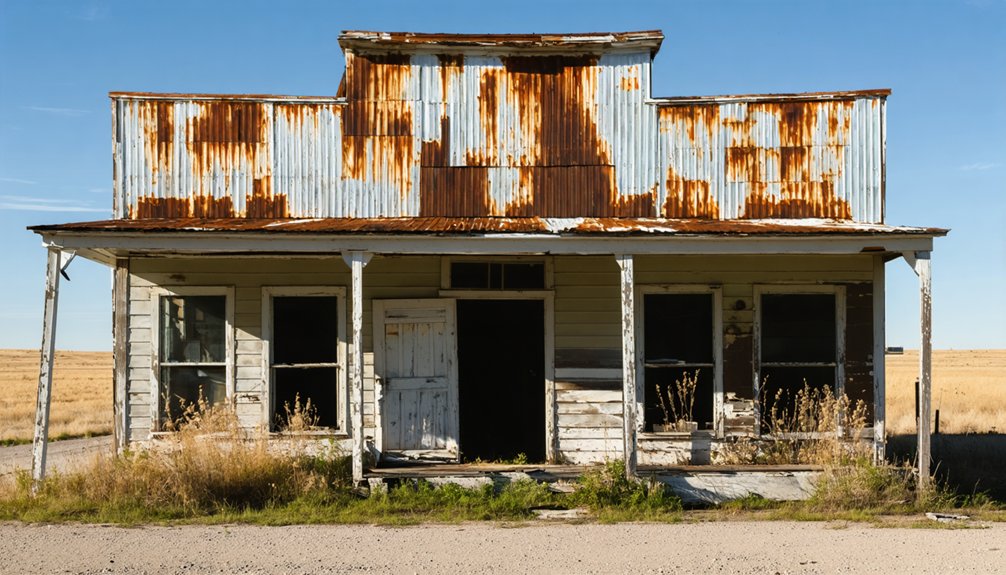You’ll find Ilka’s ghost town roots in its 1870s origins as a strategic railway stop that transformed into a booming mining settlement. The Galveston, Harrisburg and San Antonio Railway established shipping operations here, but it was John W. Spencer’s 1880s silver discovery that put Ilka on the map. The Presidio Mining Company extracted millions of tons of ore before resource depletion led to decline by the 1940s. The site’s archaeological remains hold countless untold stories of Texas’s industrial past.
Key Takeaways
- Ilka transformed from a Native American territory to a bustling settlement after 1870, centered around railway connections and mining operations.
- The town flourished as a major silver mining hub in the 1880s, with the Presidio Mining Company extracting approximately 2 million tons.
- Railroad infrastructure made Ilka a vital shipping nexus for timber, minerals, and agricultural products during its peak years.
- Economic decline began in the 1940s due to depleted silver resources and increasing production costs.
- Archaeological investigations continue today, with only 5% of the site excavated and preservation efforts facing various challenges.
Origins and Early Settlement
While Native American groups originally inhabited the area around Ilka, Texas, permanent settlement didn’t begin until after 1870, following a period of intense territorial conflicts.
Territorial clashes between settlers and Native Americans delayed permanent settlement around Ilka until well after the Civil War ended.
You’ll find that early settler conflicts shaped the cautious development of the region, with a tragic incident involving the kidnapping and killing of a young settler girl remaining a powerful influence on local folklore.
As you explore Ilka’s origins, you’ll discover that brave settlers established trading posts serving area ranches, building essential infrastructure like general stores, blacksmith shops, and cotton gins. Much like in nearby chili capitol Terlingua, these early settlers worked to build a unique community identity.
These pioneers chose locations near dependable water sources, particularly artesian wells, which proved vital for sustaining both their communities and livestock.
Indigenous interactions gradually transformed from hostile encounters to an uneasy coexistence as permanent settlements took root through the 1880s. Similar tensions existed in nearby settlements like Baby Head town, where violent conflicts between settlers and Native Americans left lasting impacts on regional history.
Railroad Connections and Trade Routes
As you explore Ilka’s railroad history, you’ll find this small East Texas town served as a strategic collection point where local tap lines connected timber shipments to larger regional railways.
The town’s shipping station handled freight transfers of pine lumber, cotton, and agricultural goods that moved along routes connecting to major hubs in Dallas, Houston, and Shreveport. Like the historic tent city growth in Shumla, Texas, the area initially expanded rapidly due to railroad development. Along this stretch of track, crews reported encounters with the Ghost Hill phantom that mysteriously stopped trains in the 1880s.
These rail connections proved essential to Ilka’s brief prosperity, linking local producers to broader markets through the expanding Texas railroad network of the late 19th and early 20th centuries.
Strategic Rail Junction Location
During the late 19th century, Ilka’s strategic position at the convergence of multiple regional rail lines established it as a vital transportation hub in Texas. The town’s railway infrastructure included wye track configurations that enabled efficient train switching between the Texas and Pacific Railway and local short lines. Similar to the triangular junction wye built in Fort Worth by the Rock Island Railway in 1903, these configurations facilitated smooth train movements between different rail lines. Texas’ vast size required extensive rail networks like Ilka’s to effectively connect populated areas across the state.
You’ll appreciate how Ilka’s trade connections revolutionized regional commerce through:
- Direct access to major markets like Dallas, Fort Worth, and Texarkana
- Seamless integration with north-south and east-west corridors
- Significant linkages between Texas interior and national distribution networks
- Strategic positioning for international trade routes extending to Mexico
This junction’s location proved instrumental in breaking through economic barriers, allowing unrestricted flow of goods and people across the expanding Texas frontier.
Shipping Station Operations
The Galveston, Harrisburg and San Antonio Railway established Ilka’s shipping station in 1875, initially as a construction camp that evolved into a key freight handling point.
You’d find typical facilities of the era there – sidings for loading goods, water towers for steam locomotives, and telegraph stations coordinating train movements.
The station’s freight management operations connected to major networks like the Texas and Pacific Railway and Texas Mexican Railway. The Houston & Central Texas railroad’s arrival in 1872 expanded regional connectivity.
You could see complex interchange logistics in action, with crews managing cargo transfers between different rail lines. The station thrived with increasing oil shipments as crude oil freight became a dominant cargo type by 1928.
While specific volume figures aren’t recorded, the station handled significant agricultural shipments and raw materials.
Logistical challenges included coordinating crew changes at border points and managing seasonal traffic peaks tied to harvest times.
The station’s infrastructure supported both local distribution and broader regional trade networks.
Regional Trade Impact
While Ilka’s modest station served local needs, its strategic position within Texas’s expanding rail network amplified its regional trade significance. The town’s access to major lines like the Houston and Texas Central Railroad transformed local trade dynamics, creating economic interdependence with larger markets.
You’ll appreciate how Ilka’s position in the rail network affected regional commerce in these ways:
- Connected local timber operations to Houston-Dallas markets through tap lines
- Provided critical links to Shreveport’s bustling trade routes via the International & Great Northern
- Enabled immigrant workers to establish thriving communities supporting industrial growth
- Facilitated rapid movement of coal and agricultural products through freight-sharing agreements
Similar to Jefferson’s 226 steamboat arrivals in 1872, these rail connections helped Ilka transcend its small-town status, integrating it into Texas’s broader economic landscape until its eventual decline. Local residents reported ghostly train sounds echoing through the abandoned tracks, reminiscent of its once-bustling railway days.
Economic Rise and Resource Extraction
As you explore Ilka’s early development, you’ll find that silver prospector John W. Spencer‘s 1880s discovery transformed this remote Texas location into a bustling quarrying operation under the Presidio Mining Company’s management.
The town’s strategic position and mining success attracted railroad developers, who established essential shipping connections that moved approximately 2 million tons of silver ore to market over several decades.
While the mining operations initially fueled remarkable growth, the eventual depletion of silver deposits and rising production costs led to the town’s economic decline by the 1940s.
Quarrying Operations Begin
Limestone quarrying operations emerged near Ilka in the early 20th century, marking a pivotal shift in the region’s economic landscape.
You’ll find that the Texas Quarry’s documented beginnings in 1926 revolutionized local industry through innovative limestone extraction methods and expanding economic opportunities.
- You’re walking in the footsteps of Irish immigrant laborers who pioneered the quarrying methods, carving out both a living and the region’s future.
- You’ll discover the impressive room-and-pillar technique used in underground mining, particularly in the south and eastern sections.
- You can trace how these quarries transformed from immigrant-worked pits into major suppliers for national monuments.
- You’re witnessing the legacy of an operation that didn’t just extract stone – it built communities, supported families, and shaped America’s architectural heritage.
Railroad Shipping Hub Forms
The arrival of the Texas & Pacific Railway in the 1870s transformed Ilka from a quarrying outpost into a vital shipping nexus.
As railroad expansion pushed westward from Dallas, you’d have seen Ilka’s strategic position strengthen when it became a key junction point for transporting resources across Texas. Multiple rail lines converged here, creating an efficient hub where timber, agricultural products, and minerals moved smoothly between rural areas and urban centers.
The town’s shipping efficiency soared through interline agreements that streamlined cargo transfers between different rail operators.
You would’ve witnessed Ilka’s economic boom as businesses and investors flocked to the railway terminal, establishing warehouses and freight yards.
The junction’s importance grew further when belt lines were added to handle increasing rail traffic and prevent downtown congestion.
Resource Depletion Impact
During the early 1880s, mineral discoveries sparked Ilka’s dramatic transformation from a railway hub into a booming extraction center. As prospectors and investors poured in, you’d have witnessed a rapid influx of workers seeking fortune in the newly established mines.
This economic migration brought unprecedented cultural diversity as immigrant laborers settled with their families, building a vibrant community around the extraction operations.
- Mining companies constructed extensive infrastructure, creating hundreds of jobs
- Merchants and traders established shops to serve the growing population
- Schools and churches emerged to support diverse immigrant families
- Social clubs and gathering spaces fostered community bonds
When mineral veins eventually ran dry, Ilka’s prosperity vanished. Workers departed, businesses shuttered, and the once-bustling town slowly transformed into the ghost town you’ll find today.
Daily Life in the Boomtown Era
Life in Ilka’s boomtown era mirrored the intense rhythm of similar mining settlements across Texas, where populations swelled into the thousands seemingly overnight.
You’d have found yourself among a primarily male workforce, laboring through long days in the mines or on railroad construction, returning to hastily built wooden homes or crowded boarding houses.
Daily amenities were basic but essential – you’d rely on general stores for essentials, while saloons served as both entertainment hubs and informal meeting spots.
Despite harsh conditions, community gatherings at churches and local festivals helped forge bonds among the diverse mix of settlers.
You’d witness the stark contrast between temporary workers living in tents and established families in frame houses, all sharing the challenges of limited sanitation and utilities as the town struggled to keep pace with its explosive growth.
Architectural and Structural Legacy

Standing tribute to Ilka’s mining heyday, adobe structures and tin-roofed buildings now paint a portrait of late 19th-century boomtown architecture.
You’ll discover architectural resilience in these utilitarian designs, where function ruled over form in serving the town’s industrial needs.
The historical significance of Ilka’s remaining structures reveals itself through:
- The 1887 jail, now a bed and breakfast, showcasing classic penal architecture
- St. John’s Catholic Church’s transformation from wood to brick, despite its crumbling bell tower
- Long bunkhouses that housed the mining workforce, evidence of the town’s industrial peak
- Preserved cupolas atop key buildings, serving both practical ventilation and watchful oversight
Today, these architectural elements tell the story of a once-thriving community, though preservation remains limited due to economic constraints.
The Path to Abandonment
While many Texas ghost towns share similar stories of decline, Ilka’s path to abandonment unfolded through a perfect storm of economic and environmental challenges in the early 20th century.
You’ll find that community decline accelerated as young residents sought better opportunities in urban areas, leaving behind an aging population struggling to maintain local institutions.
The town’s economic stagnation intensified when changes in transportation networks left it isolated from crucial trade routes.
Environmental factors, including potential water source depletion and agricultural difficulties, further pushed residents away.
Unlike some neighboring communities that adapted to changing times, Ilka couldn’t diversify its economic base or modernize its infrastructure.
The combined impact of resource depletion, demographic shifts, and inability to evolve ultimately sealed the town’s fate.
Modern-Day Site Exploration

Today’s visitors to Ilka encounter a haunting tableau of Texas history, where nature steadily reclaims the remnants of this once-vibrant community.
Time stands frozen in Ilka’s ghostly remains, as wildflowers and vines slowly embrace what’s left of this forgotten Texas town.
For urban exploration enthusiasts and historical photography buffs, you’ll need to navigate rural backroads with GPS guidance, as limited signage marks the way to this remote Guadalupe County location.
- You can explore crumbling foundations and weather-worn structures that tell silent stories of the past.
- You’ll discover prime spots for capturing authentic ghost town photographs among overgrown vegetation.
- You’re free to wander the undeveloped grounds, but watch for hazards in unstable buildings.
- You must bring all necessary supplies, as there aren’t any facilities or services on-site.
Remember to respect preservation rules while documenting your visit to this atmospheric piece of Texas heritage.
Archaeological Discoveries and Artifacts
Archaeological investigations at Ilka have barely scratched the surface, with less than 5% of the ghost town’s site excavated to date.
Through careful artifact analysis, archaeologists have uncovered numerous household items, including ceramic fragments, nails, and glass pieces that paint a picture of daily frontier life. You’ll find that excavation methods have prioritized non-invasive techniques to map underground features before any major digging begins.
The site has yielded foundations of log cabins and taverns, along with fireplace bases that mark where residents once gathered.
Most discoveries remain in situ or have been reburied to protect them from looters and environmental damage. Given the rich archaeological patterns found at other Texas sites like Gault, Ilka likely holds thousands more artifacts waiting to be discovered beneath its soil.
Preserving Ilka’s Historical Memory

Since the mid-20th century, dedicated community organizations have spearheaded efforts to preserve Ilka’s rich historical legacy through a combination of local events and collaborative initiatives.
Through active community engagement and historical storytelling, local historians and volunteer groups work tirelessly to keep Ilka’s past alive for future generations.
Key preservation efforts include:
- Annual heritage festivals celebrating Ilka’s cultural traditions
- Documentation of oral histories from former residents and their descendants
- Creation of a digital archive containing historical photographs and documents
- Maintenance of remaining structures through volunteer restoration projects
You’ll find the town’s historical society working closely with county officials to secure funding while organizing educational programs that emphasize Ilka’s role in Texas’s development.
Despite challenges of private property restrictions, preservationists continue their mission of protecting this irreplaceable piece of regional history.
Frequently Asked Questions
What Natural Disasters, if Any, Contributed to Ilka’s Decline?
You won’t find evidence of natural disasters contributing to Ilka’s decline. Based on historical records, it’s more likely economic decline and social changes drove the town’s abandonment, like many Texas ghost towns.
Were There Any Notable Crimes or Lawlessness Reported in Ilka?
You won’t find historical records of notable crimes or widespread lawlessness in Ilka. Unlike other Texas ghost towns with documented violent pasts, there’s no evidence of significant criminal activity or ghostly encounters here.
Did Indigenous Peoples Have Settlements in the Ilka Area Before?
You’d think Ilka’s remote location meant isolation, but archaeological evidence shows rich indigenous history there, with nomadic tribes establishing seasonal settlements along ancient pathways for thousands of years before European arrival.
What Happened to the Residents After They Left Ilka?
You’ll find relocation stories show former residents scattered to nearby growing cities, seeking better jobs and opportunities, though this migration disrupted tight-knit community bonds they’d built over generations.
Are There Any Surviving Photographs of Ilka During Its Peak?
Despite countless searches through Texas archives, you won’t find any confirmed historical documentation or photographic evidence of Ilka during its peak. Like 90% of small railroad camps, its visual history remains lost.
References
- https://www.chron.com/life/travel/article/ghost-towns-texas-18425049.php
- https://texashighways.com/travel-news/four-texas-ghost-towns/
- https://www.youtube.com/watch?v=QvkD3isDi8c
- https://www.youtube.com/watch?v=phjUE19A8HM
- https://freepages.history.rootsweb.com/~gtusa/usa/tx.htm
- https://en.wikipedia.org/wiki/List_of_ghost_towns_in_Texas
- https://www.tshaonline.org/handbook/entries/ilka-tx
- https://www.onlyinyourstate.com/experiences/virginia/vacant-ghost-town-va
- https://www.texasescapes.com/TOWNS/Texas-Ghost-Towns-2-Central-Texas.htm
- https://authentictexas.com/texas-ghost-towns/



